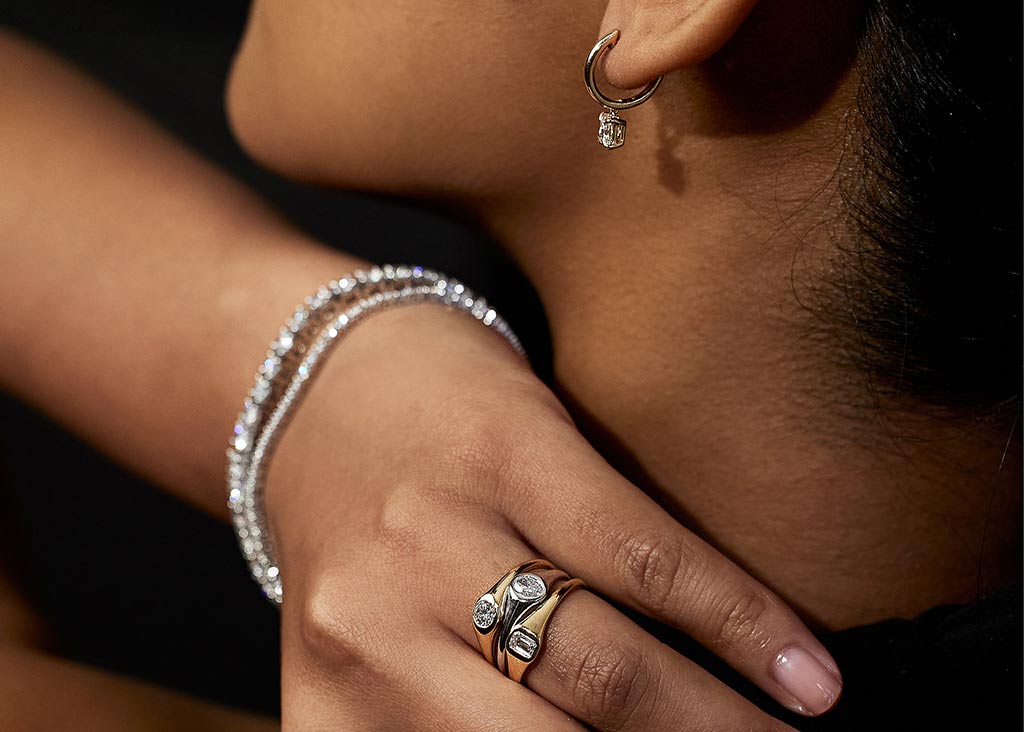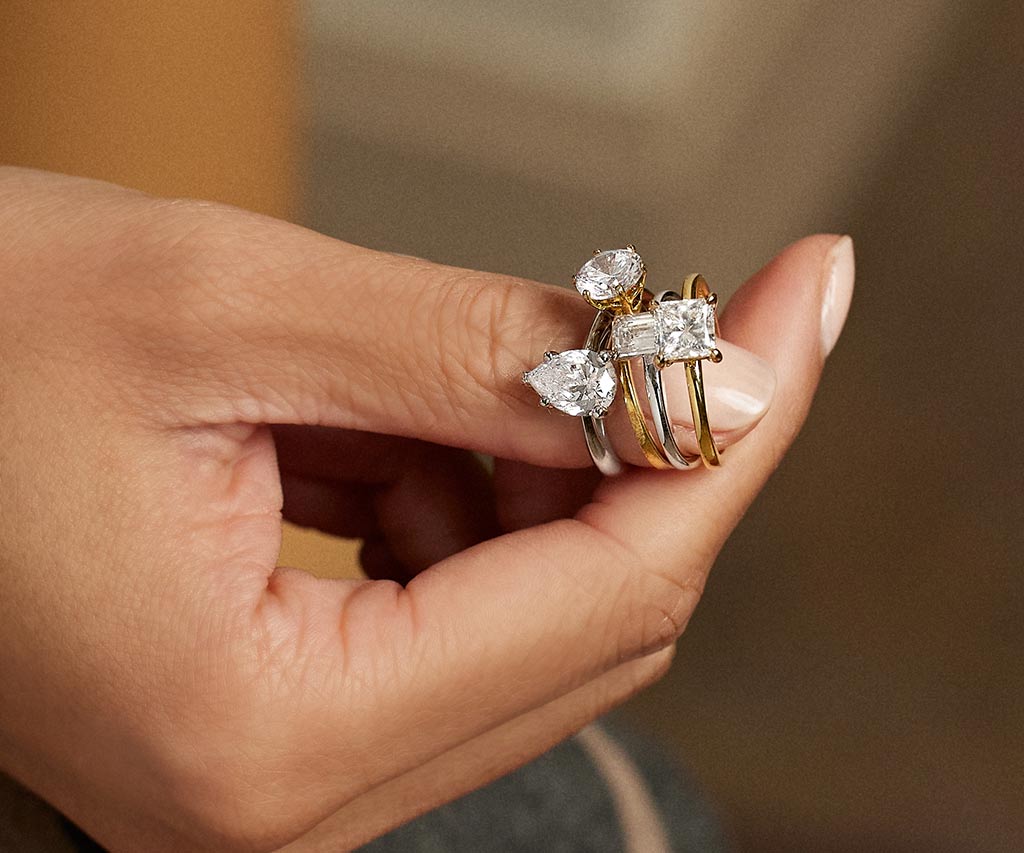Five Reasons Lab Grown Diamonds are Trending

Business of Fashion has named 2023 “The Year of the Lab Grown Diamond.” It seems like the trend of lab-grown diamonds is in the news every day. Taylor Swift, Zoe Saldana, Emma Watson, Jennifer Lopez, Reese Witherspoon and Meghan Markle have worn them on the red carpet, to premieres, on television, and out on the town.
As a result, more and more brands and consumers are deciding that it’s now the right time to switch from mined diamonds to their lab-grown counterparts. Prada announced its first fine jewelry collection featuring lab grown diamonds, including a $274,500 necklace with 40 carats of lab grown diamonds that would have cost over million if it were set with mined diamonds. The LVMH luxury brand Fred in Paris announced a new collection featuring lab grown diamonds, including a 8.88-carat blue lab grown diamond the brand has named “The Audacious Blue,” which will tour the world.
Millennial and Gen Z consumers, the main purchasers of diamonds for engagement rings, are much less likely to buy traditional mined diamonds to pledge their love. In a recent survey by The MVEye, nearly 70% of millennials are considering buying lab grown diamond engagement rings. Why are lab-grown diamonds in so much demand right now? Here are the top five reasons that lab grown diamonds are the gem of the year, and likely to be trending for years to come.
Because Lab Grown Diamonds are Diamonds
The first reason lab grown diamonds are trending is that they’re diamonds. No other gem has the same irresistible combination of brilliance, durability and an icy white color that seems to radiate light. Diamonds, whether they formed in the earth or in a lab, are unique optically, physically and chemically.
Diamonds, whether lab grown or mined, actually slow down light to half-speed, making it reflect and refract into rainbows and scintillation. They have more atoms per square millimeter than any other substance on Earth. In fact, you’d have to warp to a white dwarf star to find something with more molecular density. Those tight atomic bonds mean that diamond is a perfect ten out of ten on the Mohs scale of gemstone hardness. And diamonds, whether they form in the lab or deep in the Earth, are the only gem composed of a single element.
Those exceptional optical physical and chemical properties mean that diamonds are everyone’s favorite accessory. Their unrivalled hardness and enduring beauty have also made them the symbol of love, a romantic way to say forever, and the most popular gemstone for engagement rings.

Lab Grown Diamonds are an Amazing Value
Lab grown diamonds may look exactly the same as mined diamonds but their prices tags don’t. At all. Lab grown diamonds cost a fraction what mined diamonds cost. And the bigger the carat weight, the bigger the difference. Expect to pay one-half the price of a mined diamond for the same quality. You can afford to supersize your lab grown diamond and upgrade to the kind of quality you’ve always wanted. Multiple carats, icy color and crystal clarity are no longer out of reach. That's why many women are upgrading to the lab grown diamond necklaces and lab grown diamond earrings in the styles and carat weights they always wanted.
Lab Grown Diamonds are Pure
The gorgeous fine quality of lab-grown diamonds is no accident. When the process to grow diamonds in the lab was first developed, the created diamonds were off color and full of inclusions. In the past few years, scientists have refined their equipment and techniques to improve the size, color, and clarity of the diamond crystals grown in the labs. The largest polished lab grown gems are still smaller than the largest mined diamonds: the record set by the 3,107 carat Cullinan rough diamond, now part of the British Crown Jewels isn’t in danger yet. But cut lab grown diamonds up to five carats are now widely available.
Lab grown diamonds are Type IIa diamonds, a classification that means that their crystals are remarkably free from impurities. Type IIa are the purest type of diamonds, with virtually no nitrogen, the common element that causes the yellowish tint in most natural diamonds. Less than 2% of natural diamonds are Type IIa. That includes the Cullinan: that elite status now has to be shared with lab grown diamonds. The purity of lab grown diamonds also makes them a powerful symbol of true love.

Lab Grown Diamonds Offer Sustainable Luxury
Miners go to the ends of the earth and the bottom of the ocean to find natural diamonds. On average, mining every carat displaces 250 tons of earth, requires 120 gallons of water and emits 143 pounds of CO2. Growing lab grown diamonds takes a lot of energy to forge the strong bonds that make these crystals of carbon so exceptional. But innovative growers have turned to renewable sources for that energy. At Brilliant Carbon, we are proud that our supplier uses 100% solar and wind power to create our beautiful lab grown diamonds. And our supplier also offsets the carbon emitted from shipping and worker transportation so our lab grown diamonds can be certified climate neutral and carbon neutral. And every purchase from Brilliant Carbon gives back: you can even choose the cause your purchase will support in the shopping cart.
Lab Grown Diamonds are Transparent (in More Ways Than One)
Lab grown diamonds have excellent clarity. They are also completely transparent. With a direct pipeline from the grower to you, our lab grown diamonds are traceable from the lab to your hands. A natural diamond can change hands as many as 20 times from the miner to the jewelry store. That’s why it’s very challenging to trace natural diamonds every step of the way. In many cases, it’s not even possible to tell what country natural diamonds were mined in. That’s why it’s been a real challenge to eliminate Russian mined diamonds from the market today, despite the sanctions in the Unites States and Europe.
In addition to being traceable, lab grown diamonds have their quality graded by independent gemological institutions so you can be sure of their quality. In fact, the same gemological laboratories grade both lab grown diamonds and natural diamonds using the same standards and grading scale, the 4Cs of diamond quality. You can be confident that a natural diamond and a lab grown diamond with the same quality grades will look the same.
Can Demand for Lab Grown Diamonds Continue to Grow?
The market for lab-grown diamond jewelry has grown rapidly over the past few years as more and more consumers learn about the benefits of choosing this innovative new way to sparkle. Despite the increase in lab grown diamond production, there are still many fewer carats of lab grown diamonds produced each year than mined diamonds. In 2020, 7 million carats of rough lab grown diamonds were grown. In contrast, 111 million carats of rough diamonds were mined, according to Bain & Company. That’s why we can expect sales of lab grown diamonds to continue to grow rapidly. It looks like 2024 will be The Year of the Lab Grown Diamond too.


